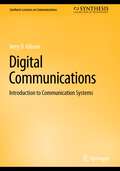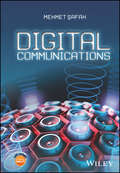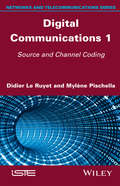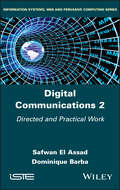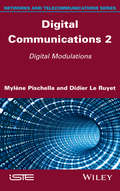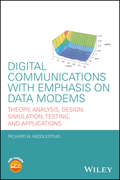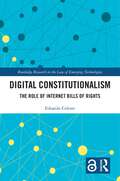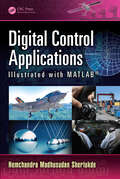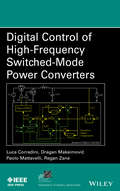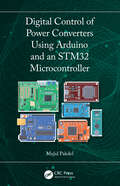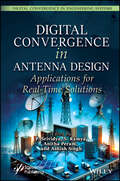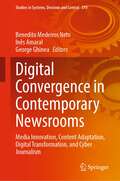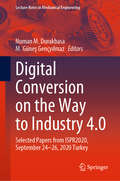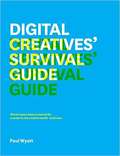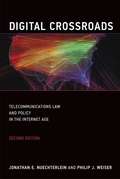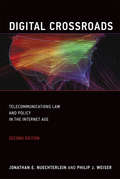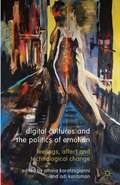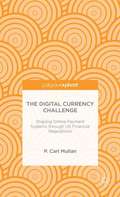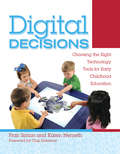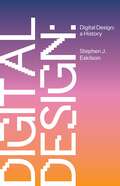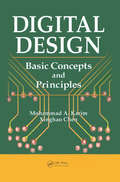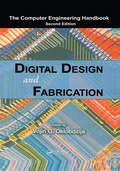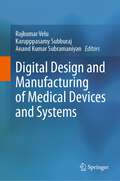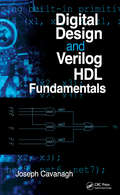- Table View
- List View
Digital Communications: Introduction to Communication Systems (Synthesis Lectures on Communications)
by Jerry D. GibsonThis book develops the concepts for the transmission of digital information sequences through analog, band limited channels, including the topics of pulse shaping, channels with amplitude and delay distortion, eye patterns, zero forcing and mean squared error equalization, and data scrambling. The text considers the effects of noise in digital communications, developing the fundamental ideas of signal space, optimum symbol-by-symbol detection, and modulation system design, with particular emphasis on maximum likelihood and maximum a posteriori detection and system performance comparisons based on energy per bit to noise ratio and average error probability. The key technique of maximum likelihood sequence estimation is also developed. Tutorial coverage provides an introduction to block and convolutional codes for error control coding, including coding and decoding methods for error detection and correction, tree and trellis representations, and Viterbi decoding. Some performance comparisons for selected codes in terms of energy per bit to noise ratio versus bit error probability are presented. This book examines joint coding and modulation methods such as constant envelope modulation and trellis coded modulation, including examples such as minimum shift keying and offset quadrature phase shift keying.
Digital Communications
by Mehmet SafakThis is a modern textbook on digital communications and is designed for senior undergraduate and graduate students, whilst also providing a valuable reference for those working in the telecommunications industry. It provides a simple and thorough access to a wide range of topics through use of figures, tables, examples and problem sets. The author provides an integrated approach between RF engineering and statistical theory of communications. Intuitive explanations of the theoretical and practical aspects of telecommunications help the reader to acquire a deeper understanding of the topics. The book covers the fundamentals of antennas, channel modelling, receiver system noise, A/D conversion of signals, PCM, baseband transmission, optimum receiver, modulation techniques, error control coding, OFDM, fading channels, diversity and combining techniques, MIMO systems and cooperative communications. It will be an essential reference for all students and practitioners in the electrical engineering field.
Digital Communications 1: Source and Channel Coding
by Didier Le Ruyet Mylène PischellaThe communication chain is constituted by a source and a recipient, separated by a transmission channel which may represent a portion of cable, an optical fiber, a radio channel, or a satellite link. Whatever the channel, the processing blocks implemented in the communication chain have the same foundation. This book aims to itemize. In this first volume, after having presented the base of the information theory, we will study the source coding techniques with and without loss. Then we analyze the correcting codes for block errors, convutional and concatenated used in current systems.
Digital Communications 2: Directed and Practical Work
by Safwan El Assad Dominique BarbaIt is a complete training in digital communications in the same book with all the aspects involved in such training: courses, tutorials with many typical problems targeted with detailed solutions, practical work concretely illustrating various aspects of technical implementation implemented. It breaks down into three parts. The Theory of information itself, which concerns both the sources of information and the channels of its transmission, taking into account the errors they introduce in the transmission of information and the means of protect by the use of appropriate coding methods. Then for the technical aspects of transmission, first the baseband transmission is presented with the important concept and fundamental technique of equalization. The performance evaluation in terms of probability of errors is systematically developed and detailed as well as the online codes used. Finally, the third part presents the Transmissions with digital modulation of carriers used in radio transmissions but also on electric cables. A second important aspect in learning a learner's knowledge and skills is this book. It concerns the "Directed Work" aspect of a training. This is an ordered set of 33 typical problems with detailed solutions covering the different parts of the course with practical work. Finally, the last aspect concerns the practical aspects in the proper sense of the term, an essential complement to training going as far as know-how. We propose here a set of 5 practical works.
Digital Communications 2
by Mylène Pischella Didier Le RuyetThis second volume covers the following blocks in the chain of communication: the modulation baseband and transposed band, synchronization and channel estimation as well as detection. Variants of these blocks, the multicarrier modulation and coded modulations are used in current systems or future.
Digital Communications with Emphasis on Data Modems: Theory, Analysis, Design, Simulation, Testing, and Applications
by Richard W. MiddlesteadThis book uses a practical approach in the application of theoretical concepts to digital communications in the design of software defined radio modems. This book discusses the design, implementation and performance verification of waveforms and algorithms appropriate for digital data modulation and demodulation in modern communication systems. Using a building-block approach, the author provides an introductory to the advanced understanding of acquisition and data detection using source and executable simulation code to validate the communication system performance with respect to theory and design specifications. The author focuses on theoretical analysis, algorithm design, firmware and software designs and subsystem and system testing. This book treats system designs with a variety of channel characteristics from very low to optical frequencies. This book offers system analysis and subsystem implementation options for acquisition and data detection appropriate to the channel conditions and system specifications, and provides test methods for demonstrating system performance. This book also: Outlines fundamental system requirements and related analysis that must be established prior to a detailed subsystem design Includes many examples that highlight various analytical solutions and case studies that characterize various system performance measures Discusses various aspects of atmospheric propagation using the spherical 4/3 effective earth radius model Examines Ionospheric propagation and uses the Rayleigh fading channel to evaluate link performance using several robust waveform modulations Contains end-of-chapter problems, allowing the reader to further engage with the text Digital Communications with Emphasis on Data Modems is a great resource for communication-system and digital signal processing engineers and students looking for in-depth theory as well as practical implementations.
Digital Community, Digital Citizen
by Jason B. OhlerAn all-inclusive roadmap to citizenship in the 21st Century Best-selling author, educator, and futurist Jason Ohler challenges all readers to redefine our roles as citizens in today’s globally connected infosphere. His text aligns the process of teaching digital citizenship with the ISTE standards definition, and uses an “ideal school board” device to address fears, opportunities, and the critical issues of character education. These issues include: Cyberbullying, “sexting,” and other safety concerns Students’ ability to creatively access and critically assess information Respect and ethics regarding copyrighted information Communicating appropriately in an expanded and public realm
Digital Constitutionalism: The Role of Internet Bills of Rights (Routledge Research in the Law of Emerging Technologies)
by Edoardo CelesteInvestigating the impact of digital technology on contemporary constitutionalism, this book offers an overview of the transformations that are currently occurring at constitutional level, highlighting their link with ongoing societal changes. It reconstructs the multiple ways in which constitutional law is reacting to these challenges and explores the role of one original response to this phenomenon: the emergence of Internet bills of rights. Over the past few years, a significant number of Internet bills of rights have emerged around the world. These documents represent non-legally binding declarations promoted mostly by individuals and civil society groups that articulate rights and principles for the digital society. This book argues that these initiatives reflect a change in the constitutional ecosystem. The transformations prompted by the digital revolution in our society ferment under a vault of constitutional norms shaped for ‘analogue’ communities. Constitutional law struggles to address all the challenges of the digital environment. In this context, Internet bills of rights, by emerging outside traditional institutional processes, represent a unique response to suggest new constitutional solutions for the digital age. Explaining how constitutional law is reacting to the advent of the digital revolution and analysing the constitutional function of Internet Bills of Rights in this context, this book offers a global comparative investigation of the latest transformations that digital technology is generating in the constitutional ecosystem and highlights the plural and multilevel process that is contributing to shape constitutional norms for the Internet age.
Digital Control Applications Illustrated with MATLAB
by Hemchandra Madhusudan ShertukdeDigital Control Applications Illustrated with MATLAB covers the modeling, analysis, and design of linear discrete control systems. Illustrating all topics using the micro-computer implementation of digital controllers aided by MATLAB, Simulink, and FEEDBACK<<, this practical text:Describes the process of digital control, followed by a review
Digital Control of High-Frequency Switched-Mode Power Converters
by Regan Zane Dragan Maksimović Luca Corradini Paolo MattavelliThis book is focused on the fundamental aspects of analysis, modeling and design of digital control loops around high-frequency switched-mode power converters in a systematic and rigorous manner. Comprehensive treatment of digital control theory for power converters Verilog and VHDL sample codes are provided. Enables readers to successfully analyze, model, design, and implement voltage, current, or multi-loop digital feedback loops around switched-mode power converters. Practical examples are used throughout the book to illustrate applications of the techniques developed Matlab examples are also provided.
Digital Control of Power Converters Using Arduino and an STM32 Microcontroller
by Majid PakdelThis concise and accessible guide equips readers with the knowledge and skills needed to implement digital control algorithms to design efficient and reliable power converters using STM32 microcontrollers.Through this book, Majid Pakdel covers a range of topics including digital control theory, switching converters theory, the design and implementation of control algorithms (such as proportional–integral–derivative and advanced digital control techniques), programming of STM32 microcontrollers, and interfacing with power electronics components. He also provides step-by-step tutorials and code examples to help readers understand and implement the concepts in their own projects. Readers will gain a deep understanding of digital control techniques in power converters, learn how to program STM32 microcontrollers for control applications, and be able to design and implement their own digital control algorithms in power electronics systems. The practical examples provided in the book will help readers apply the knowledge gained to real-world projects and improve their skills in developing digital control systems.The information within is useful for young professionals and students aiming at experimental implementation on a microcontroller platform of a control algorithm for power converters. To fully benefit from the practical examples demonstrating digital controller implementation on the STM32, readers should have a solid understanding of power switching converter topologies, modeling, and control.
Digital Convergence in Antenna Design: Applications for Real-Time Solutions (Digital Convergence in Engineering Systems)
by P. Srividya S. Ramya Anitha Peram Ashish SinghDIGITAL CONVERGENCE in ANTENNA DESIGN The latest addition to this series presents high-quality original research contributions on analytical and practical models and ideas in the field of antennas, including a thorough look at RF techniques like antennas, RFID, and filters with special emphasis on real-time applications like e-health, RADAR, and mobile and satellite communications. This book is intended to disseminate recent trends in antenna designs for real-time applications that leverage digital convergence. The book intends to report the latest research findings, as well as the state-of-the-art RF techniques related to antennas, RFID, filters, etc., with special emphasis on real-time applications like e-health, RADAR, and mobile and satellite communications. The book can be used as a reference for researchers who want to explore the convergence of AI/ML/DL, big data, and IoT in the areas of antenna and advanced communication technologies for real-time applications. These real-time applications can include e-healthcare, intelligent transportation, aerospace, retail, manufacturing, industrial plants, and defense products where communications play a major role.
Digital Convergence in Contemporary Newsrooms: Media Innovation, Content Adaptation, Digital Transformation, and Cyber Journalism (Studies in Systems, Decision and Control #370)
by Benedito Medeiros Neto Inês Amaral George GhineaThis book explores the dynamic landscape in contemporary newsrooms across three continents by investigating the impact that the processes of searching, processing, and distributing data and information and the use of big data, with secure, automatic, and agile retrieval of information all have in this context. Journalistic organizations have undergone digital transformations, and only those implementing accurate transformations survive. In so doing, the book addresses the fields of e-Communication, Computer Science, and Information Science and other areas of the authors’ expertise. The first five chapters focus on technical visits to investigate newsrooms’ productive routines and flows in major dailies from Brazil, Costa Rica, and England. The remaining chapters consider that the news production routines are cooperative and distributed and at the same time need to be managed from different perspectives to support the convergence of digital media. Last but not least, the book also identifies an increase in ICT-based tools, with an increasing connection from new media combined with the growing trend of digital economy practices as important factors in the new landscape of digital journalism.
Digital Conversion on the Way to Industry 4.0: Selected Papers from ISPR2020, September 24-26, 2020 Online - Turkey (Lecture Notes in Mechanical Engineering)
by Numan M. Durakbasa M. Güneş GençyılmazThis book presents the proceedings from the International Symposium for Production Research 2020. The cross-disciplinary papers presented draw on research from academics and practitioners from industrial engineering, management engineering, operational research, and production/operational management. It explores topics including: · computer-aided manufacturing; Industry 4.0 applications; simulation and modeling big data and analytics; flexible manufacturing systems; decision analysis quality management industrial robotics in production systems information technologies in production management; and optimization techniques. Presenting real-life applications, case studies, and mathematical models, this book is of interest to researchers, academics, and practitioners in the field of production and operation engineering.
The Digital Creative's Survival Guide: Everything You Need for a Successful Career in Web, App, Multimedia and Broadcast Design
by Paul Wyatt<p>Take control of your digital media career! <p>When it comes to the web and mobile, only one thing is guaranteed, and that's change. If you're a creative working in this ever changing field and looking for answers, look no further. <p>The Digital Creative's Survival Guide gives you the insider's edge you need to stay inspired, informed, and employed. This must-have reference is packed with practical advice on topics like managing studio politics, dealing with nightmare clients, using good digital project management practices, understanding design briefs and finding your niche in a constantly changing industry. Within these pages, you'll discover: <p> <li>Interviews with successful creatives from around the world. <li>Deconstructions of digital design projects that worked. <li>Practical career information and advice for staying marketable and "future-proof." <li>And much more!</li> <p> <p>Showcasing the work and wisdom from some of the best digital creatives in the business today, The Digital Creative's Survival Guide is the tool you need to take control of your career and stay relevant no matter what happens in the industry.</p>
Digital Crossroads: Telecommunications Law and Policy in the Internet Age, 2nd ed.
by Jonathan E. Nuechterlein Philip J. WeiserIn "Digital Crossroads," two experts on telecommunications policy offer a comprehensive and accessible analysis of the regulation of competition in the U. S. telecommunications industry. The first edition of "Digital Crossroads" (MIT Press, 2005) became an essential and uniquely readable guide for policymakers, lawyers, scholars, and students in a fast-moving and complex policy field. In this second edition, the authors have revised every section of every chapter to reflect the evolution in industry structure, technology, and regulatory strategy since 2005. The book features entirely new discussions of such topics as the explosive development of the mobile broadband ecosystem; incentive auctions and other recent spectrum policy initiatives; the FCCs net neutrality rules; the National Broadband Plan; the declining relevance of the traditional public switched telephone network; and the policy response to online video services and their potential to transform the way Americans watch television. Like its predecessor, this new edition of Digital Crossroads not only helps nonspecialists climb this fields formidable learning curve, but also makes substantive contributions to ongoing policy debates.
Digital Crossroads, second edition: Telecommunications Law and Policy in the Internet Age
by Jonathan E. Nuechterlein Philip J. WeiserA thoroughly updated, comprehensive, and accessible guide to U.S. telecommunications law and policy, covering recent developments including mobile broadband issues, spectrum policy, and net neutrality.In Digital Crossroads, two experts on telecommunications policy offer a comprehensive and accessible analysis of the regulation of competition in the U.S. telecommunications industry. The first edition of Digital Crossroads (MIT Press, 2005) became an essential and uniquely readable guide for policymakers, lawyers, scholars, and students in a fast-moving and complex policy field. In this second edition, the authors have revised every section of every chapter to reflect the evolution in industry structure, technology, and regulatory strategy since 2005. The book features entirely new discussions of such topics as the explosive development of the mobile broadband ecosystem; incentive auctions and other recent spectrum policy initiatives; the FCC's net neutrality rules; the National Broadband Plan; the declining relevance of the traditional public switched telephone network; and the policy response to online video services and their potential to transform the way Americans watch television. Like its predecessor, this new edition of Digital Crossroads not only helps nonspecialists climb this field's formidable learning curve, but also makes substantive contributions to ongoing policy debates.
Digital Cultures and the Politics of Emotion
by Athina Karatzogianni Adi KuntsmanFifteen thought-provoking essays engage in an innovative dialogue between cultural studies of affect, feelings and emotions, and digital cultures, new media and technology. The volume provides a fascinating dialogue that cuts across disciplines, media platforms and geographic and linguistic boundaries.
The Digital Currency Challenge: Shaping Online Payment Systems through US Financial Regulations (Palgrave Pivot)
by P. Carl Mullan<p>Private online digital currency systems offer people accessible, convenient, and inexpensive everyday financial tools outside of traditional bank-owned and operated platforms. Digital currency systems facilitate local and international fund transfers, online and offline payments, and simple cash-to-digital everyday financial products without the need for a conventional bank account of any retail bank product. Over the past several years, Bitcoin has grown into an efficient person-to-person and person-to-business payment system without the backing of any bank or financial institution. This phenomenon is producing a new level of an on- and offline commerce and a society much more attuned to digital currency systems. <p>The Digital Currency Challenge details how new 2007-2008 U.S. legal issues surrounding digital currency products forced companies from the U.S. market and caused the Treasury Department to enact stricter regulations. Mullan profiles new and innovative present day digital currency systems, such as Bitcoin, and illustrates how software designers and monetary theorists use new technology to circumvent current U.S. regulations. This work also explains how new digital currency systems are not just software products, but tools providing financial freedom to people in countries all around the world.</p>
Digital Decisions: Choosing the Right Technology Tools for Early Childhood Education
by Karen Nemeth Fran Simon Chip Donohue"Digital Decisions will open your eyes and expand your awareness of how technology fits into a purposefully planned child-centered classroom."- Paula Jorde Bloom, Michael W. Louis Endowed Chair, McCormick Center for Early Childhood Leadership "Simon and Nemeth transform the debate between technology as good or bad, rather showing us how to use technology actively and interactively within good active and interactive early childhood programs." -Ellen Galinsky, Author, Mind in the Making: The Seven Essential Life Skills Every Child Needs Feel confident and competent when it comes to choosing and implementing the most appropriate technology tools for your early childhood classroom! Whether you are a technology enthusiast looking for new ideas and guidance about developmentally appropriate practices, or you are new to the idea of using technology with young children, this book is for you.Digital Decisions provides everything you need to make your own technology plan based on your experiences and beliefs, the needs of the children, the context of your curriculum and the resources available to you. This no-nonsense, jargon-free guide will help you evaluate the tools and opportunities technology has to offer and integrate them into your early childhood classroom so you can offer real-life, hands-on, interactive activities to children. A reference every childhood program will want to have, Digital Decisions is brimming with charts, resources, and an array of activities that maximize technology as an interactive learning tool. Each chapter provides supporting guidance to make technology most effective for those working with children who are dual language learners or may have special needs.
Digital Design: A History
by Stephen EskilsonA groundbreaking history of digital design from the nineteenth century to todayDigital design has emerged as perhaps the most dynamic force in society, occupying a fluid, experimental space where product design intersects with art, film, business, engineering, theater, music, and artificial intelligence. Stephen Eskilson traces the history of digital design from its precursors in the nineteenth century to its technological and cultural ascendency today, providing a multifaceted account of a digital revolution that touches all aspects of our lives.We live in a time when silicon processors, miniaturization, and CAD-enhanced 3D design have transformed the tangible world of cars and coffee makers as well as the screen world on our phones, computers, and game systems. Eskilson provides invaluable historical perspective to help readers better understand how digital design has become such a vibrant feature of the contemporary landscape. He covers topics ranging from graphic and product design to type, web design, architecture, data visualization, and virtual reality. Along the way, he paints compelling portraits of key innovators behind this transformation, from foundational figures such as Marshall McLuhan, Nam June Paik, and April Greiman to those mapping new frontiers, such as Jeanne Gang, Jony Ive, Yugo Nakamura, Neri Oxman, and Jewel Burks Solomon.Bringing together an unprecedented array of sources on digital design, this comprehensive and richly illustrated book reveals how many of the digital practices we think of as cutting-edge actually originated in the analog age and how the history of digital design is as much about our changing relationship to forms as the forms themselves.
Digital Design: Basic Concepts and Principles
by Mohammad A. Karim Xinghao Chen<p>In today’s digital design environment, engineers must achieve quick turn-around time with ready accesses to circuit synthesis and simulation applications. This type of productivity relies on the principles and practices of computer aided design (CAD). Digital Design: Basic Concepts and Principles addresses the many challenging issues critical to today’s digital design practices such as hazards and logic minimization, finite-state-machine synthesis, cycles and races, and testability theories while providing hands-on experience using one of the industry’s most popular design application, Xilinx Web PACK. <p>The authors begin by discussing conventional and unconventional number systems, binary coding theories, and arithmetic as well as logic functions and Boolean algebra. Building upon classic theories of digital systems, the book illustrates the importance of logic minimization using the Karnaugh map technique. It continues by discussing implementation options and examining the pros and cons of each method in addition to an assessment of tradeoffs that often accompany design practices. The book also covers testability, emphasizing that a good digital design must be easy to verify and test with the lowest cost possible. <p>Throughout the text, the authors analyze combinational and sequential logic elements and illustrate the designs of these components in structural, hierarchical, and behavior VHDL descriptions. Coveringfundamentals and best practices, Digital Design: Basic Concepts and Principles provides you with critical knowledge of how each digital component ties together to form a system and develops the skills you need to design and simulate these digital components using modern CAD software.</p>
Digital Design and Fabrication (Computer Engineering Series)
by Vojin G. OklobdzijaIn response to tremendous growth and new technologies in the semiconductor industry, this volume is organized into five, information-rich sections. Digital Design and Fabrication surveys the latest advances in computer architecture and design as well as the technologies used to manufacture and test them. Featuring contributions from leading experts, the book also includes a new section on memory and storage in addition to a new chapter on nonvolatile memory technologies. Developing advanced concepts, this sharply focused book— Describes new technologies that have become driving factors for the electronic industry Includes new information on semiconductor memory circuits, whose development best illustrates the phenomenal progress encountered by the fabrication and technology sector Contains a section dedicated to issues related to system power consumption Describes reliability and testability of computer systems Pinpoints trends and state-of-the-art advances in fabrication and CMOS technologies Describes performance evaluation measures, which are the bottom line from the user’s point of view Discusses design techniques used to create modern computer systems, including high-speed computer arithmetic and high-frequency design, timing and clocking, and PLL and DLL design
Digital Design and Manufacturing of Medical Devices and Systems
by Rajkumar Velu Karupppasamy Subburaj Anand Kumar SubramaniyanThis book coherently presents the advances in technological principles, processes, and methods of Additive Manufacturing (AM), Augmented reality (AR), and Internet of things (IoT) in biomedical technology. It offers an overview of these high-impact technologies in terms of materials, processes, and in-situ monitoring of fabricating biomedical devices, implants, and prosthetics. Furthermore, the book also aimed to cover pedagogical applications, including the design and development of high-fidelity anatomical and hybrid physiological human models, for medical and design students and clinicians for learning, understanding, and gaining insights into the structures and functions of human organs and pathology. In turn, the book also discusses the applications of artificial intelligence in the 3-D printing of pharmaceuticals. This book is a useful resource for manufacturers, scientists, engineers, and young research scholars understand disruptive technology's real potential in biomedicalapplications.
Digital Design and Verilog HDL Fundamentals
by Joseph CavanaghComprehensive and self contained, this tutorial covers the design of a plethora of combinational and sequential logic circuits using conventional logic design and Verilog HDL. Number systems and number representations are presented along with various binary codes. Several advanced topics are covered, including functional decomposition and iterative networks. A variety of examples are provided for combinational and sequential logic, computer arithmetic, and advanced topics such as Hamming code error correction. Constructs supported by Verilog are described in detail. All designs are continued to completion. Each chapter includes numerous design issues of varying complexity to be resolved by the reader.
